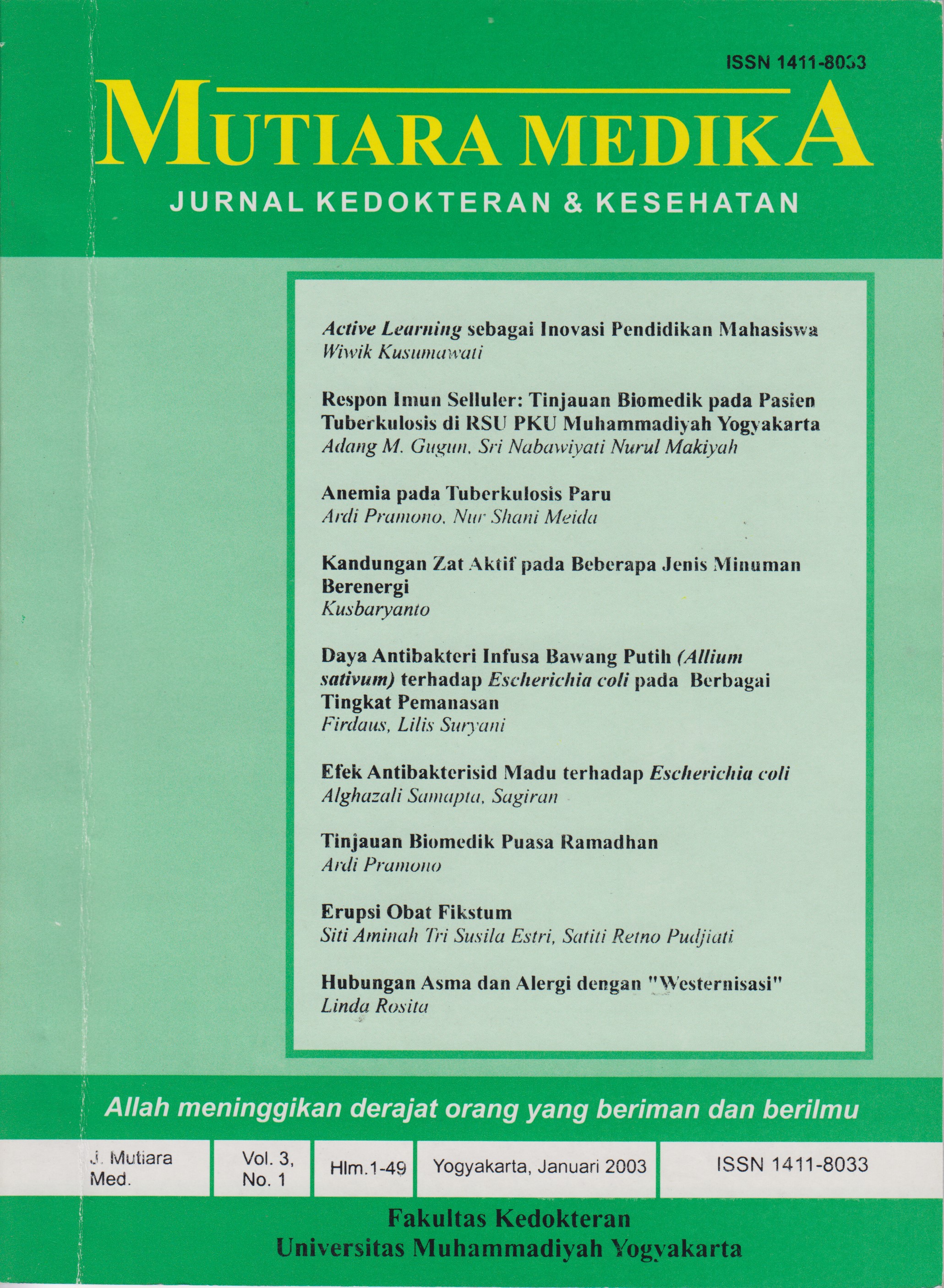Efek Antibakterisid Madu terhadap Escherichia coli
DOI:
https://doi.org/10.18196/mmjkk.v3i1.1544Keywords:
madu, antibakteri, Escherichia coli, honey, antibacteriaAbstract
Allah Azza Wa J alia said in Quran, “From inside a bee’s stomach it is spread off a colourful drink, which consists of medicine that may cure human diseases. (QS. 16:69). The term of “Back to Nature”, brings us to go back to nature, lets human to see alternative medicine besides the conventional medi-cine. There are some limitations of conventional antibiotic, i.e. causing bacte¬ria resistence and side effects in quite a lot cases. This is much different with “honey”, which posseses some superiorities such as easy administration, good absorption, minimal side effects and affordable price of medicine. The antibacterial activity of honey can be used as an alternative antibac-terial remedy which is more superior and has minimal side effect. In Islam, honey is a nutrition, food supplement and a medicine as well. The objective of this research was to reveal the antibacterial effect of honey against Escheri¬chia coli by relating it to the Islam knowledge and technology. The characteristic of honey that has antibacterial activity, is known as the effect of “inhibition ”. The antibacterial avtivity is related to total composition of honey, i.e. high sugar concentration, acidity and the presence of pollen. It is also influenced by a substance like lysozyme, which is more commomly known as inhibine. The antibacterial activity of honey is also related to its osmotic process.. Honey is a saturation liquid and supersaturation of sugar which was said to possess osmotic capability. Water molecule reacts strongly to sugar in honey, leaving only a little water to the microorganism ’s life. Decomposi¬tion of hidrogen peroxide increases reactive-free radical molecules that will react to bacteria and kill it. Osmotic pressure causes hidration of bacteria which hence can not survive.
Allah Azza Wa Jalla berfirman dalam Al Qur’an, "Dari perut lebah itu keluar minuman yang bermacam-macam warnanya,di dalamnya terdapat obat yang menyembuhkan bagi manusia (Q.S.16:69).Istilah,11 Back to nature ”, mengembalikan diri kepada alam, membawa manusia untuk melihat obat alternatif lainnya, disamping obat-obatan yang modem. Terdapat keterbatasan dari antibiotik konvensional, yaitu mengakibatkan resistensi terhadap bakteri dan cukup banyak mengakibatkan efek samping. Madu, mempunyai kelebihan yaitu mudah cara pemberiannya, baik absorbsinya, efek samping minimal, adanya infeksi ganda dan harga obat yang terjangkau. Daya antibakteri yang terdapat dalam madu dapat digunakan sebagai antibakteri alternatif. Efek antibakteri yang dimiliki madu lebih unggul dan juga memiliki efek samping yang ditimbulkan sangat minim. Dalam Islam madu merupakan suatu nutrisi, suplemen tambahan sekaligus obat. Tujuan penulisan ini adalah untuk mengetahui efek antibakterisid madu terhadap Escherichia coli dengan mengkaitkan pengetahuan Islam dan teknologi. Sifat madu yang memiliki daya antibakteri, disebut efek “inhibisi”. Daya antibakteri berhubungan dengan komposisi total dari madu, yaitu konsentrasi gula yang tinggi, keasaman dan adanya pollen. Dan juga di pengaruhi oleh senyawa sejenis lysozime atau yang lebih dikenal dengan inhibine. Aktivitas antibakterial madu juga berhubungan dengan proses osmotiknya. Madu merupakan larutan saturasi 'dan supersaturasi dari gula yang dikatakan punya kemampuan osmotik. Molekul air bereaksi kuat dengan gula pada madu, menyisakan sedikit air untuk kehidupan mikroorganisme. Dekomposisi hidrogen peroksida meningkatkan radikal bebas yang reaktif yang akan bereaksi dengan bakteri dan membunuhnya. Tekanan osmotik menyebabkan bakteri terhidrasi sehingga bakteri tidak dapat hidup.
References
Sarwono, B., 2001, Kiat Mengatasi permasalahan Praktis Lebah Madu, Agro Media Pustaka, Tanggerang.
Martono, 1993, Beternak Lebah Madu Modern, Bharata Karya Aksara, Jakarta.
Winamo, F.G, 1981 ,Madu, Teknologi, Khasiat dan Analisa, Ghalia Indonesia, Jakarta.
Salle, 1961, Staphylococci Edwin H. Lennette, Albert Ballows, Williams, J., Hauster Jr, & H Jean Shadomy, Manual of Clinical Microbiologi, 4 — th, edition American Society for Microbiol¬ogy, Washington D.C.
Trihendrokesowo ., Setiabudy, R., Ganiswara, V.H.S., 1995, Pengantar Antimikroba dalam Ganiswara, S.G: Farmakologi dan Terapi, Bagian Farmakologi FKUI, Jakarta.
Yahya, H., 2002, Menyingkap Rahasia Alam Semesta, Dzikra, Bandung
Jutono, E., Melnick, J.L., E.A. Adelberg, GF. Brooks, J.S. Butel, & L.N. Omston, 1989 Medical Microbiologi, Departemen Microbiologi Fakultas Pertanian UGM, Yogyakarta.
Patra, K. dan S. Santoso, 1980, Membangun dan Mengembangkan Peternakan Lebah Madu di Indonesia, Penerbit Kitara, Bandung
White, J.W., 1978, Honey in Chichester, C.O. : Advances in Food Research, Academic Press London.
Letchumanan, S., 1997, Studies on The Antibacterial Action of Honey, tanpa edisi.
Carthy., Julie, 1995, Penisilin, Sefalosporin da Antibiotik Betalaktam Lainnya, dalam Farmakologi FK UI, Jakarta.
Jawetz, E., Melnick, J.L., Adelberg, E. A., 1986, Mikrobiologi Kedokteran, Edisi 20, EGC, Jakarta.
Molan, P.C., 1997, Honey for The Treatment of Infection, University of Waikato, New Zealand.
Downloads
Published
Issue
Section
License
Copyright
Authors retain copyright and grant Mutiara Medika: Jurnal Kedokteran dan Kesehatan (MMJKK) the right of first publication with the work simultaneously licensed under an Attribution 4.0 International (CC BY 4.0) that allows others to remix, adapt and build upon the work with an acknowledgment of the work's authorship and of the initial publication in Mutiara Medika: Jurnal Kedokteran dan Kesehatan (MMJKK).
Authors are permitted to copy and redistribute the journal's published version of the work (e.g., post it to an institutional repository or publish it in a book), with an acknowledgment of its initial publication in Mutiara Medika: Jurnal Kedokteran dan Kesehatan (MMJKK).
License
Articles published in the Mutiara Medika: Jurnal Kedokteran dan Kesehatan (MMJKK) are licensed under an Attribution 4.0 International (CC BY 4.0) license. You are free to:
- Share — copy and redistribute the material in any medium or format.
- Adapt — remix, transform, and build upon the material for any purpose, even commercially.
This license is acceptable for Free Cultural Works. The licensor cannot revoke these freedoms as long as you follow the license terms. Under the following terms:
Attribution — You must give appropriate credit, provide a link to the license, and indicate if changes were made. You may do so in any reasonable manner, but not in any way that suggests the licensor endorses you or your use.
- No additional restrictions — You may not apply legal terms or technological measures that legally restrict others from doing anything the license permits.






